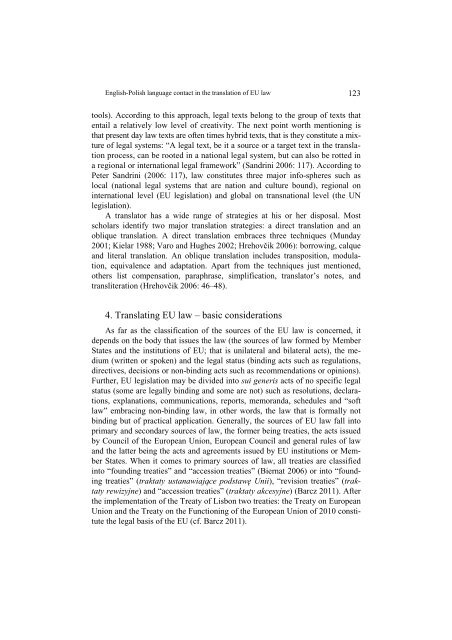s - Wyższa SzkoÅa Filologiczna we WrocÅawiu
s - Wyższa SzkoÅa Filologiczna we WrocÅawiu
s - Wyższa SzkoÅa Filologiczna we WrocÅawiu
Create successful ePaper yourself
Turn your PDF publications into a flip-book with our unique Google optimized e-Paper software.
English-Polish language contact in the translation of EU law 123<br />
tools). According to this approach, legal texts belong to the group of texts that<br />
entail a relatively low level of creativity. The next point worth mentioning is<br />
that present day law texts are often times hybrid texts, that is they constitute a mixture<br />
of legal systems: “A legal text, be it a source or a target text in the translation<br />
process, can be rooted in a national legal system, but can also be rotted in<br />
a regional or international legal framework” (Sandrini 2006: 117). According to<br />
Peter Sandrini (2006: 117), law constitutes three major info-spheres such as<br />
local (national legal systems that are nation and culture bound), regional on<br />
international level (EU legislation) and global on transnational level (the UN<br />
legislation).<br />
A translator has a wide range of strategies at his or her disposal. Most<br />
scholars identify two major translation strategies: a direct translation and an<br />
oblique translation. A direct translation embraces three techniques (Munday<br />
2001; Kielar 1988; Varo and Hughes 2002; Hrehovčik 2006): borrowing, calque<br />
and literal translation. An oblique translation includes transposition, modulation,<br />
equivalence and adaptation. Apart from the techniques just mentioned,<br />
others list compensation, paraphrase, simplification, translator’s notes, and<br />
transliteration (Hrehovčik 2006: 46–48).<br />
4. Translating EU law – basic considerations<br />
As far as the classification of the sources of the EU law is concerned, it<br />
depends on the body that issues the law (the sources of law formed by Member<br />
States and the institutions of EU; that is unilateral and bilateral acts), the medium<br />
(written or spoken) and the legal status (binding acts such as regulations,<br />
directives, decisions or non-binding acts such as recommendations or opinions).<br />
Further, EU legislation may be divided into sui generis acts of no specific legal<br />
status (some are legally binding and some are not) such as resolutions, declarations,<br />
explanations, communications, reports, memoranda, schedules and “soft<br />
law” embracing non-binding law, in other words, the law that is formally not<br />
binding but of practical application. Generally, the sources of EU law fall into<br />
primary and secondary sources of law, the former being treaties, the acts issued<br />
by Council of the European Union, European Council and general rules of law<br />
and the latter being the acts and agreements issued by EU institutions or Member<br />
States. When it comes to primary sources of law, all treaties are classified<br />
into “founding treaties” and “accession treaties” (Biernat 2006) or into “founding<br />
treaties” (traktaty ustanawiające podstawę Unii), “revision treaties” (traktaty<br />
rewizyjne) and “accession treaties” (traktaty akcesyjne) (Barcz 2011). After<br />
the implementation of the Treaty of Lisbon two treaties: the Treaty on European<br />
Union and the Treaty on the Functioning of the European Union of 2010 constitute<br />
the legal basis of the EU (cf. Barcz 2011).
















